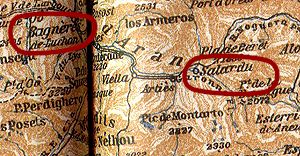|
4. Some Cycling - and Bagneres-des-Luchon to Salardu On arrival in Luchon, we had spotted a couple of bicycle hire shops and, seeing as Antony and I have some experience in two wheeled adventures we decided to spend a day cycling around Luchon before we headed for Spain. It was nearly midday by the time we had had a late breakfast, hired the bicycles and bought lunch provisions. Both mountain bikes, had a 27 gears, front suspension and the most fearsome set of brakes we have ever encountered - we felt suitably equipped for the Pyrenees. The plan was to cycle up to the village of Saint Aventin and then explore some of the forest tracks that lay to the south. Unfortunately on the way up to the village, Antony discovered his physical limits (I cycle off road quite often so didn't suffer as much), the difficulty of the steep climb compounded by heat and humidity. It took us well over an an hour to ascend the 5km to Saint Aventin, a feat that doesn't compare favourably to the 13 minutes that the Tour de France riders managed a few weeks later on their ascent of the Col de Peyresourde. Saint Aventin is a picturesque twelfth century village that clings to the side of an impossibly steep valley - we think that it is slightly eccentric that the residents of the village choose to drive regular saloon cars around its ridiculous streets. We both took several photographs, but the minute we looked through the viewfinder it was apparent that no photo could do justice to the views. The wooded hillsides were a striking shade of green. According to the Rough Guide, Aventin was a hermit who was chummy with the local bears; the church has a carving of a bear on one of its capitals. Sadly there are now, at most, 150 Pyrenean brown bears left in the Pyrenees - the following paragraph from Nagel's France (3rd edition 1956) gives a likely explanation:
Plummeting down the steep road that crosses the valley we enjoyed the first bit cycling of the day, and came to realise quite why the brakes needed to be so efficient. Keeping as much momentum going as possible we pedaled franticly up the other side of the valley. The initial climb to Saint Aventin had given us a better idea of how to pace ourselves and we climbed slowly through the woods which after a while began to overlook Luchon. We stopped for lunch only to be assaulted by a plague of flies. So many in fact that the tunnel web spider buried in the roadside bank didn't seem interested in the stick I offered it. After lunch (and a puncture repair) we continued in the same direction only to be thwarted about thirty minutes later by a logging operation that blocked the road. Reluctantly we headed back to Saint Aventin. Before leaving we decided to take look at the river that had carved this valley and within about 20 seconds of leaving the road I managed to hit a small rock and, hauling on the (super efficient) brakes in an attempt to keep my balance found myself thrown half off - the handlebars hit the ground first, my knee came to rest on the handlebars and the remainder of the bike came to rest on my knee moments later. "I was going to suggest we stop here", I ventured, much to Antony's amusement, who described the whole move as quite balletic. The bruise finally went about four months later. The descent down to Luchon was thrilling (and slightly scary) and completed in about 10 minutes! We still had plenty of time before we needed to return the bikes so we decided to explore the valley floor where things were a whole lot flatter. We took a pleasant country road that followed the east bank of the River Pique for 10 km or so, crossing to the other bank to return. Light aircraft and gliders buzzed and whispered overhead - yet another activity that you can pursue from Luchon. We had enjoyed our time there but it was time to move on - to Spain. We left Luchon at around 5pm and back in the car crossed the border over the heavily wooded Col du Portillon - a pair of rather unimpressive graffiti daubed pillars marking the frontier. After a mile or so the road widened as if in response to the scale of the terrain - throughout our tour we found the Spanish Pyrenees wilder and more dramatic than the French side. We drove down into the Vall D'Aran, the little corner of Spain that until 1958 was almost inaccessible from the rest of the country - the construction of the Tunel de Viella finally, permitting access from the South. From Viella we headed west for the village of Salurdu climbing a wide valley now littered with ski developments, tower cranes poking out of the middle - much is under construction. The chalet accommodation makes you feel like you're in Switzerland rather than in Spain. Arriving in Salardu we checked into the local bar, a highly civilised arrangement which permits you to leave the bar for bed at around 12:30am (the buildings may look Swiss but the hours are very Spanish!) and return to the same bar for breakfast some eight hours later, all without leaving the building. We had a rather bland pizza in the only local restaurant that was open and after wandering the cobbled streets and viewing the octagonal tower of the church we returned to the bar for a beer (or two...). next: 5. Salardu to La Seu
d'Urgell
|

